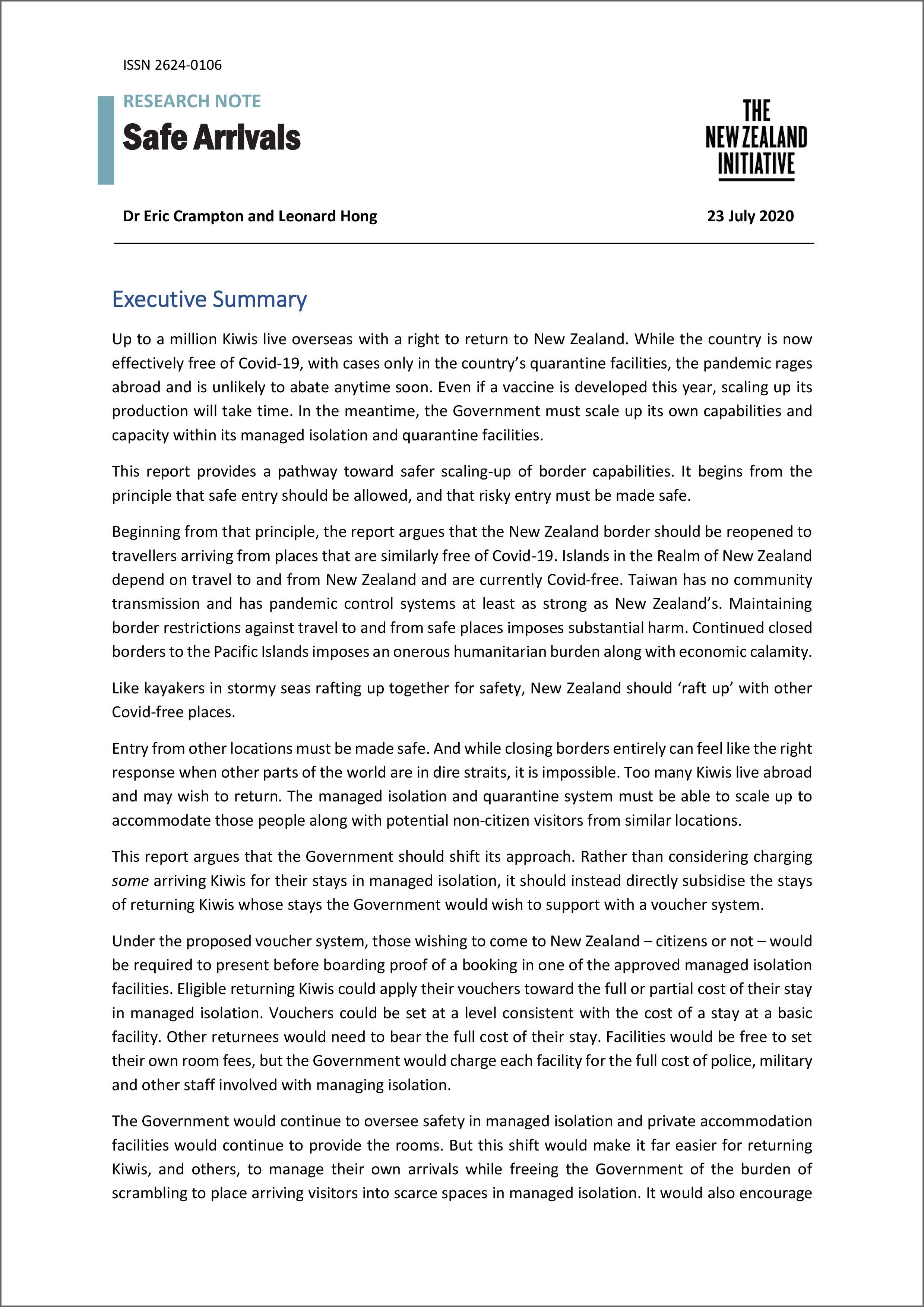Up to a million Kiwis live overseas with a right to return to New Zealand. While the country is now effectively free of Covid-19, with cases only in the country’s quarantine facilities, the pandemic rages abroad and is unlikely to abate anytime soon. Even if a vaccine is developed this year, scaling up its production will take time. In the meantime, the Government must scale up its own capabilities and capacity within its managed isolation and quarantine facilities.
This report provides a pathway toward safer scaling-up of border capabilities. It begins from the principle that safe entry should be allowed, and that risky entry must be made safe.
Beginning from that principle, the report argues that the New Zealand border should be reopened to travellers arriving from places that are similarly free of Covid-19. Islands in the Realm of New Zealand depend on travel to and from New Zealand and are currently Covid-free. Taiwan has no community transmission and has pandemic control systems at least as strong as New Zealand’s. Maintaining border restrictions against travel to and from safe places imposes substantial harm. Continued closed borders to the Pacific Islands imposes an onerous humanitarian burden along with economic calamity.
Like kayakers in stormy seas rafting up together for safety, New Zealand should ‘raft up’ with other Covid-free places.
Entry from other locations must be made safe. And while closing borders entirely can feel like the right response when other parts of the world are in dire straits, it is impossible. Too many Kiwis live abroad and may wish to return. The managed isolation and quarantine system must be able to scale up to accommodate those people along with potential non-citizen visitors from similar locations.
This report argues that the Government should shift its approach. Rather than considering charging some arriving Kiwis for their stays in managed isolation, it should instead directly subsidise the stays of returning Kiwis whose stays the Government would wish to support with a voucher system.
Under the proposed voucher system, those wishing to come to New Zealand – citizens or not – would be required to present before boarding proof of a booking in one of the approved managed isolation facilities. Eligible returning Kiwis could apply their vouchers toward the full or partial cost of their stay in managed isolation. Vouchers could be set at a level consistent with the cost of a stay at a basic facility. Other returnees would need to bear the full cost of their stay. Facilities would be free to set their own room fees, but the Government would charge each facility for the full cost of police, military and other staff involved with managing isolation.
The Government would continue to oversee safety in managed isolation and private accommodation facilities would continue to provide the rooms. But this shift would make it far easier for returning Kiwis, and others, to manage their own arrivals while freeing the Government of the burden of scrambling to place arriving visitors into scarce spaces in managed isolation. It would also encourage other facilities to shift into providing managed isolation services (under Government oversight and supervision).
The present system is strained. It struggles to accommodate need, but must scale up substantially if Kiwis abroad choose to exercise their right to return home. Allocating scarce positions in managed isolation by Ministerial discretion forces Ministers into impossible positions in deciding whose need is greatest.
Being able to scale up safely is critically important. The entire country made incredibly costly efforts to make New Zealand effectively Covid-free. Some Kiwis continue to bear those costs through family separation, unemployment or failing businesses. And for a long time yet, the country will be paying off the new government debt accrued to help the economy survive lockdown.
Improving border protocols to allow for safe entry at scale would not only help those worst affected by the collective elimination efforts, it would open up opportunities that simply were not available in the pre-pandemic world. Rather than trying to estimate the extent of New Zealand’s likely economic losses, the country could be looking at stronger economic opportunities.
Recommendations
The New Zealand Government should:
- Set a principle to allow safe entry into New Zealand;
- Recognise that entry from safe places by people who have not recently been to risky places is safe. Re-open the border to entry from Taiwan and the Covid-free Pacific Islands and assess whether individual Australian states could be considered safe;
- Support the Pacific Island neighbours in ensuring safe external borders;
- Continue to assess the adequacy of safety protocols on flights to risky places and at airports handling passengers from risky places;
- Allow greater scaling-up of managed isolation by:
o Allowing those arriving to take up a greater portion of the cost: full user-pays for non-citizens and a voucher-based co-payment scheme for returning residents and citizens;
o Certifying facilities as authorised providers of managed isolation or quarantine services;
o Charging isolation facilities for the isolation management services provided by the government;
o Allowing facilities to provide their own management services if they are able to credibly demonstrate capability of doing so safely, but only under strict supervision and process auditing;
o Requiring all arrivals book their own accommodation in authorised isolation facilities and provide proof of booking before boarding flights to New Zealand;
o Training potential isolation management staff;
o Charging isolation facilities for the isolation services provided by the government on a full cost-recovery basis;
- Layering additional safety protocols for non-citizens arriving from risky places to further reduce risk as numbers increase, such as post-isolation testing and daily health check-ins;
- Consult with New Zealand’s epidemiologist community over the medium term as both testing and app-based technologies develop to assess whether alternative sets of restrictions could reduce risk at lower cost for travellers from less risky but not risk-free places.






